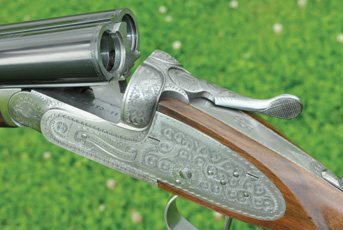William Powell Marquis
- Last updated: 16/12/2016

Last year we tested, and were impressed by, the Marquis 12 bore, a traditionally made, but competitively priced, side lock, side by side made for the respected old English firm of William Powell by Arrieta of Spain (a company not without its own reputation for endurance and integrity of manufacture). This month we look at the new 20 bore version of the Marquis. It is equipped with 30” barrels, a concave rib, and a straight-hand stock with splinter forend. It hits the scales at 6 pounds 3 ounces.
First Impressions?
Nothing fancy here, this is the least expensive sidelock in the ever expanding William Powell range. The engraving on the silver polished action does not take your breath away (but it is executed by hand). The wood is not spectacularly figured (but it is competently finished). The base price of the gun is just £3575 (10% more than its 12 bore sibling). You are not paying for any extra finish. This is a very competitive price for a true sidelock ejector gun (the cheapest English sidelock is nearly ten times as much). Have any corners been cut? Well, I have noted the engraving is ordinary (competent, inoffensive scroll) and the timber nothing special (though well presented with hand cut chequering and an oil finish). What of the rest?
The gunmaking appears sound in all departments. Wood to metal, and metal to metal fit, are better than average. I can confirm, from having seen Arrietas made, that in spite of the price in this case, they are all still bench-made guns (smoke lamps and hand-powered files are still much in evidence at the Arrieta factory). I liked the basic form of the Marquis as well which conformed to the British game gun norm. The gun closes with a reassuring feel of quality and the jointing is up to standard. Barrels are well presented and free of significant rivel or blemish. They are true chopper lump as well and plated internally (as nearly all continental guns are).
Handling
When you handle this new 20 bore Powell, it feels right, with a better than average weight distribution thanks to the sidelock design (putting weight between the hands) and extra length in the barrels promoting pointability and control. I much prefer longer barrelled 20s and 28s as regular readers will be aware. Mounting the Marquis, one is struck by fast handling and good stock shapes. The stock had a length of pull of 15 1/4” (offering the extra wood for shortening if required). The straight-grip is of Holland diamond pattern. It is not too big, yet it anchors the hand well. The splinter forend is a good size (although the end cap for the Anson push rod forend fastener looks a little bare on the aesthetic front).
Fairly plain though it may be aesthetically, the basic specification of the Marquis was sensible. I liked most of the functional details. The well proportioned concave rib was finished with a metal bead of good size and nice pawn like form. The Purdey style safety was positive to use. The shape of fences and top lever were good, and the beaded edges on the fences and the belly of the action where attractive. There were few if any eccentricities or negative points of note evident in the test gun (save perhaps for the screws visible in the base of the action balls).
Barrels
The 30” barrels, as noted, are chopper-lump. They are made from ‘Bellota’ steel (a high grade high Nickel specified type used by most of the best makers in Spain). They bear Spanish proof marks for 70mm (2 3/4) cases at 1200 K/cm2. Chokes are fixed at to allow for regulation to requirements. Forcing cones are quite short. Spanish gunmakers seem reluctant to follow the modern trend towards longer ones. The bores are both marked 15.8mm for diameter which is traditional, but on the tighter side for a 20 (some associate tighter bores with improved penetration, although others suggest it negatively impacts on felt recoil).
The action, which is made from a forging, is of classic design. It is, in essence, a Holland & Holland sidelock with disc set strikers added. V springs power the hammers, and there are intercepting safety sears in the locks. These depart slightly from the Holland pattern in that the intercepting safety sear, itself, is powered not by the usual small and delicate leaf spring, but by a small coil spring in a tube acting on a small piston/rod pushing against the sear arm. Ejector work is of reliable Southgate pattern operating on the over-centre principle.
Shooting Impressions
This little Powell shot splendidly. It was very quick to use, so quick that when I tested it on a skeet range at a partridge like bird, I had something of competition with myself to see just how fast it could be shot (answer: well before the centre peg). In spite of relatively light weight, and relatively tight bores and choke, felt recoil was modest. This may be put down to good fundamental design and good gunmaking. Yes, the aesthetics of this gun’s decoration are average, but it is a terrific gun nevertheless at a price that makes you wonder how the Spanish trade manages to do it. Some of their guns are over-priced today. This is certainly not one of them. GM
PRICE: £3575